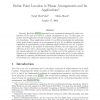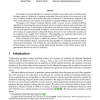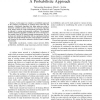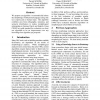IJCAI
2003
14 years 6 months ago
2003
We describe algorithms for computing Nash equilibria in structured game representations, including both graphical games and multi-agent influence diagrams (MAIDs). The algorithms...
SODA
2001
ACM
14 years 6 months ago
2001
ACM
Recently, Har-Peled [HP99b] presented a new randomized technique for online construction of the zone of a curve in a planar arrangement of arcs. In this paper, we present several ...
SODA
2001
ACM
14 years 6 months ago
2001
ACM
We present an algorithm which provably reconstructs a collection of curves with corners and endpoints from a sample set that satisfies a certain sampling condition. The algorithm ...
SODA
2001
ACM
14 years 6 months ago
2001
ACM
In this paper we present algorithms for a number of problems in geometric pattern matching where the input consist of a collections of segments in the plane. Our work consists of ...
ICWN
2003
14 years 6 months ago
2003
— In this paper we consider a probabilistic approach to the problem of localization in wireless sensor networks and propose a distributed algorithm that helps unknown nodes to de...
NIPS
2001
14 years 6 months ago
2001
This paper presents an unsupervised learning algorithm that can derive the probabilistic dependence structure of parts of an object (a moving human body in our examples) automatic...
NIPS
2001
14 years 6 months ago
2001
In previous work on "transformed mixtures of Gaussians" and "transformed hidden Markov models", we showed how the EM algorithm in a discrete latent variable mo...
OPODIS
2004
14 years 6 months ago
2004
A localized Delaunay triangulation owns the following interesting properties in a wireless ad hoc setting: it can be built with localized information, the communication cost impos...
NAACL
2001
14 years 6 months ago
2001
We propose an algorithm to automatically induce the morphology of inflectional languages using only text corpora and no human input. Our algorithm combines cues from orthography, ...
NIPS
2004
14 years 6 months ago
2004
We propose a new set of criteria for learning algorithms in multi-agent systems, one that is more stringent and (we argue) better justified than previous proposed criteria. Our cr...




